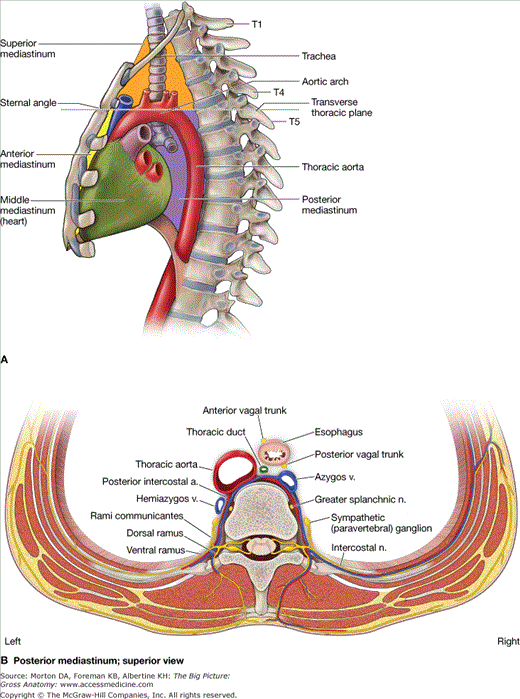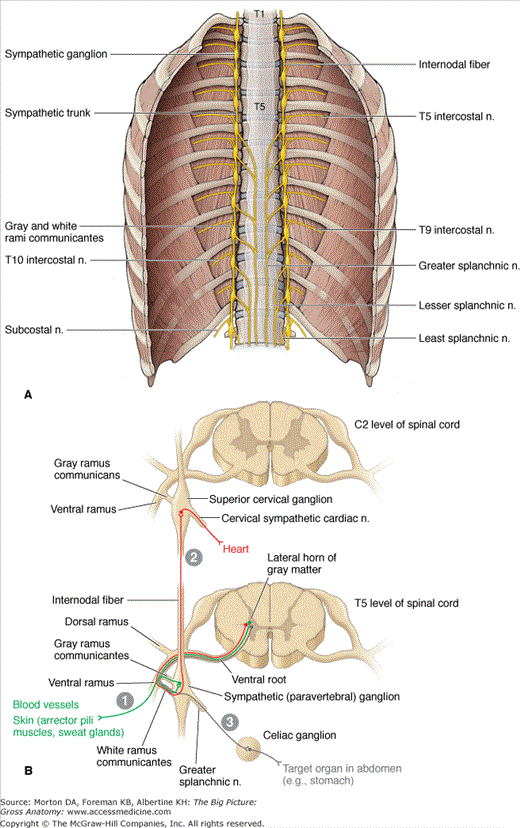Divisions of the Mediastina
The mediastinum is the anatomic region medial to the pleural sacs between the sternum, vertebral column, rib 1, and the diaphragm. The mediastinum is further divided into inferior and superior parts by a horizontal plane passing through the sternal angle to the T4–T5 intervertebral disc (Figure 5-1A). The inferior mediastinum is classically subdivided into anterior, middle, and posterior parts. Therefore, the four subregions of the mediastinum are as follows:
- Anterior mediastinum. The region between the sternal angle, the deep sternal surface, the pericardial sac, and the diaphragm. The anterior mediastinum contains fat and areolar tissue and the inferior part of the thymus or its remnant.
- Middle mediastinum. This region contains the pericardial sac and heart (see Chapter 4 for further details).
- Posterior mediastinum. The region containing anatomic structures deep to the pericardial sac, including the thoracic portion of the descending aorta, the azygos system of veins, the thoracic duct, the esophagus, and the vagus and sympathetic nerves (Figure 5-1B). This chapter will focus on the structures located in the posterior mediastinum and their projection into the superior mediastinum.
- Superior mediastinum. The region superior to the sternal angle containing the aortic arch and its three branches, the superior vena cava (SVC) and the brachiocephalic veins, the trachea, the esophagus, and the phrenic and vagus nerves. The superior mediastinum also contains the thymus; however, in an adult, the thymus is usually atrophied and presents as a fatty mass.
Sympathetic Trunk and Associated Branches
The autonomic nervous system of the thorax consists of both sympathetic and parasympathetic motor neurons through which cardiac muscle, smooth muscle, and the glands of the thorax and the abdomen are innervated. Autonomic innervation involves two types of neurons: preganglionic neurons and postganglionic neurons. The sympathetic nerves in the thorax and in other areas of the body include visceral sensory fibers that course along the general sensory neurons.
The thoracic sympathetic chain or trunk courses vertically across the heads of the ribs along the posterior thoracic wall, deep to the parietal pleura (Figure 5-2A). This location parallels the vertebral column; the sympathetic chain, therefore, is also referred to as the paravertebral ganglia. The sympathetic chain descends posterior to the diaphragm to continue its descent in the abdominal cavity.
The thoracic portion of the sympathetic trunk typically has 12 paravertebral ganglia connected to adjacent thoracic spinal nerves by white and gray rami communicantes. White rami have myelinated nerve fibers and thus appear white. Gray rami have unmyelinated nerve fibers and, therefore, appear gray. The sympathetic ganglia are numbered according to the thoracic spinal nerve with which they are associated. The chain is composed primarily of ascending and descending preganglionic sympathetic fibers and visceral afferent fibers. Each paravertebral ganglion houses the nerve cell bodies for postganglionic sympathetic nerve fibers. Internodal fibers connect sympathetic ganglia vertically, resulting in the chain or trunk.
The cell bodies for preganglionic sympathetic fibers originate in the lateral horn of the spinal cord gray matter. The axons exit the ventral root into the ventral ramus where white rami convey the preganglionic sympathetic fibers from the ventral ramus to a paravertebral ganglion. Once the preganglionic sympathetic fibers enter the paravertebral ganglion, the following possible pathways may occur (Figure 5-2B):
Preganglionic sympathetic fibers synapse with postganglionic sympathetic fibers within the ganglion, and the segmental gray rami communicantes carry the postganglionic sympathetic fibers back to the ventral ramus at the same vertebral level. The postganglionic sympathetic fibers innervate blood vessels, sweat glands, and arrector pili muscles of hair follicles within the associated dermatome.
Preganglionic sympathetic fibers enter internodal fibers, ascending to a higher ganglion (e.g., the superior cervical ganglion), where they synapse with a postganglionic fiber. Postganglionic sympathetic fibers exit the ganglion en route to the cardiac plexus (see Chapter 4, Innervation of the Heart).
Preganglionic sympathetic fibers en route to abdominal organs become thoracic splanchnic nerves. Thoracic splanchnic nerves are formed from the following levels (Figure 5-2A):
- T5–T9 unite to form the greater splanchnic nerve, which perforates the crus of the diaphragm or occasionally passes through the aortic hiatus and ends in the celiac or superior mesenteric ganglion.
- T10–T11 unite to form the lesser splanchnic nerve, which pierces the crus of the diaphragm and ends in the aorticorenal ganglion.
- T12 becomes the least splanchnic nerve, which pierces the crus of the diaphragm and ends in the renal plexus.
- T5–T9 unite to form the greater splanchnic nerve, which perforates the crus of the diaphragm or occasionally passes through the aortic hiatus and ends in the celiac or superior mesenteric ganglion.





